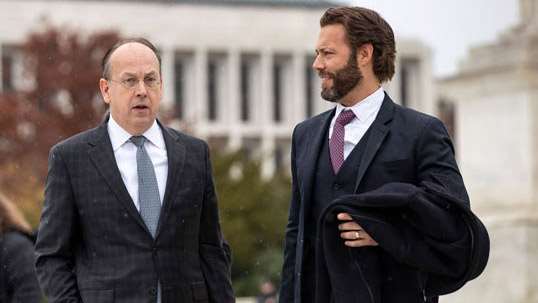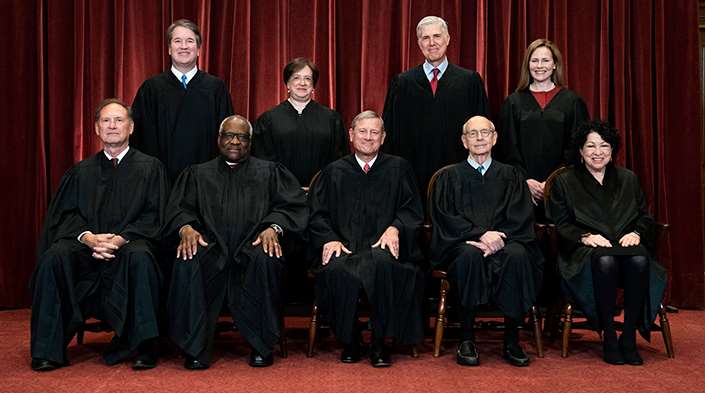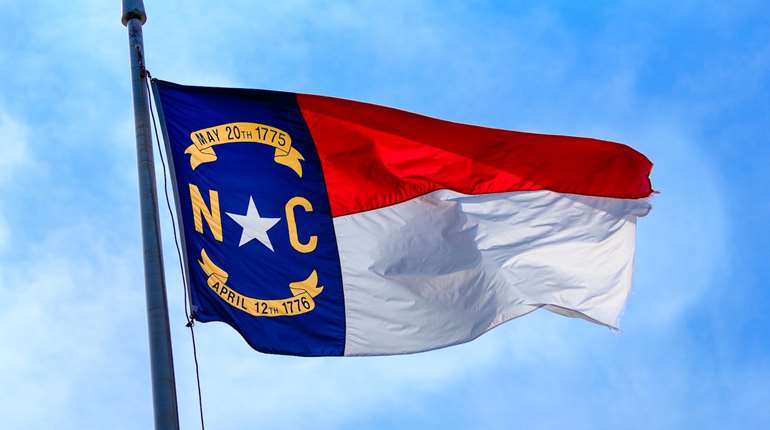
The highly anticipated oral argument in New York State Rifle and Pistol Association v. Bruen took place before the U.S. Supreme Court on Nov. 3, 2021. While predicting the outcome of a Supreme Court decision is hazardous, what was said in this hearing didn’t please gun-control advocates.
Paul Clement, former solicitor general of the United States, argued on behalf of the challengers. Barbara Underwood, solicitor general of New York, defended the law in question, as did Brian Fletcher, the principal deputy solicitor general of the United States. Other than the lawyers, the justices and select media, the courtroom was empty due to COVID restrictions, but anyone could listen to the very lively argument on the Court’s website. The following offers a blow-by-blow account of the arguments before the Court.

Everyone seemed to assume that “the people” have a right to bear arms outside the home, but it depended on whose definition of “the people” was used. To the challengers, the populace at large is included, while New York would confine the term to “atypical people” approved by the government. (Gone are the days, disposed into the dust bin of legal history by District of Columbia v. Heller (2008), when “the people” was argued to mean members of a militia on active duty.)
Justice Amy Coney Barrett asked about Times Square on New Year’s Eve. Maybe, instead of being a sensitive place, Clement responded, it could be regulated under a time, place and manner restriction, a concept borrowed from First Amendment law. While the issue of sensitive places is not before the Court, it could provide guidance on the subject.
As I learned from the cases I’ve argued in the Court, justices often argue a point in the questions they ask. Part of Justice Samuel Alito’s query stated that the core purpose of the right to keep and bear arms is self-defense, and thus a sensitive place should be a place where the state has safeguards for those who enter, such as metal detectors and security officials. While his brief argued that very point, Clement did worry that the state may declare the whole part of a city to be a sensitive place because many police are present there and, thus, “we have your back.”
True to form, Justice Stephen Breyer, a former professor, used up a good bit of Clement’s time ruminating about crime statistics, how professors of history showed Heller to be wrongly decided and how carrying for self-defense makes “you go shooting it around and somebody gets killed.” He worried about “people of good moral character who start drinking a lot and who may be there for a football game” who then might “get pretty angry at each other.”
To that, Clement pointed to the 43 or so “shall-issue” states, which include large cities like Phoenix and Houston. He said that those places “allow their citizens to have the same rights” and they have not had worse problems than the handful of states with discretionary issuance.
In response to a question from Justice Neil Gorsuch, Clement addressed the 1328 Statute of Northampton, which Sir John Knight’s Case (1686) held to apply only to carrying arms with “malo animo” (evil intent) in a manner to terrify others, and the English Bill of Rights (1689), which protected the right to have arms. Clement said that “there just are no reported cases on this side of the Atlantic ... that show anybody being prosecuted for a violation of the Northampton crime simply by carrying common firearms for self-defense.”
Justice Brett Kavanaugh asked questions about how constitutional rights are interpreted, beginning with the statement that “we [don’t] allow basic blanket discretion to grant or deny [them].” Moreover, he said, “we should focus on American law and the text of the Constitution ... which you say grants a right to carry, and then historical practice can justify certain kinds of regulations, but the baseline is always the right established in the text.” While some lower courts have used strict or intermediate scrutiny, “those are balancing tests” under which courts could make policy judgments. As a judge on the D.C. Circuit, Kavanaugh issued a dissent in Heller II v. D.C. that the correct test is text, history and tradition.
The fun really began with the argument of New York Solicitor General Barbara Underwood. She reduced the right of the people to bear arms to the whims of government officials. Despite it being an obvious outlier, she asserted that “New York is not an outlier in the extent to which the state restricts the ability to carry firearms in public, and it’s not an outlier in asking a licensed applicant to show good cause for a carry license.”

Underwood’s argument that carry permits might be more appropriate in rural areas, but not populous ones, ran into a brick wall from Chief Justice Roberts, who said it’s unlikely in the woods “to run into someone who’s going to rob you on the street. On the other hand, there are places ... in a densely populated city where it’s more likely that that’s where you’re going to need a gun for self-defense and ... however many policemen are assigned ... there are high-crime areas.”
When Underwood irrelevantly retorted that, under the English monarchies it was “an insult to the king for people to take things into their own hands,” Roberts said, “Well, how many muggings take place in the forest?” (There was some laughter then.) Underwood correctly replied that rapes and robberies do occur on deserted bike paths, but this only worsened her case.
“Yeah, that’s what I’m talking about... . They’re walking around the streets, but the ordinary, hard-working, law-abiding people I mentioned, no, they can’t be armed?” –Justice Samuel Alito
And that’s where Justice Alito lowered the boom, arguing that ordinary “people who work late at night in Manhattan … it might be somebody who cleans offices; it might be a doorman at an apartment; it might be a nurse or an orderly; it might be somebody who washes dishes.” They get off work around midnight, commute home by subway or bus and walk through a high-crime area. “And they apply for a license, and they say: Look, nobody has ... said I’m going to mug you next Thursday; however, there have been a lot of muggings in this area, and I am scared to death.”
Underwood confirmed that, “if there’s nothing particular to them,” they don’t get a carry license. So, Alito continued, “Does it mean that there is the right to self-defense for celebrities and state judges and retired police officers but pretty much not for the kind of ordinary people who have a real, felt need to carry a gun to protect themselves?” The follow-up exchange was telling:
Justice Alito: “There are ... a lot of armed people on the streets of New York and in the subways late at night right now, aren’t there?”
Underwood: “There are people with illegal guns if that’s what you’re—”
Justice Alito: “Yeah, that’s what I’m talking about... . They’re walking around the streets, but the ordinary, hard-working, law-abiding people I mentioned, no, they can’t be armed?”
Next it was Justice Kavanaugh’s turn. He asked that “the real concern, isn’t it, with any constitutional right, if it’s the discretion of an individual officer, that seems inconsistent with an objective constitutional right... . I mean, what if you’re a runner and you say I run a lot, and, as you correctly pointed out earlier, there are a lot of serious violent crimes on running paths?”
Underwood then let the cat out of the bag: “The problem with the shall-issue regimes is that they multiply the number of firearms that are being carried in very densely populated places... .”
So the constitutional right is being exercised by too many people?
That led Justice Kagan to request her to respond to Clement’s argument that “we would never really dream of doing that for the First Amendment or other constitutional rights... .”
Justice Sonia Sotomayor called her out on giving an evasive answer and repeated that, “the issue is [in] no other constitutional right do we condition on permitting different jurisdictions to pass different regulations... .” No decent answer was forthcoming.
Justice Alito asked whether “you got a little bit overly enthusiastic in your summary of some of the historical sources,” as he noted that New York’s brief used a quote from an 1814 North Carolina legal manual telling local officials to “arrest all such persons as in your sight shall ride or go armed.” Trouble is, the original source actually said “ride or go armed offensively.” Going armed peaceably was lawful. Instead of apologizing for what looked like manipulation of the source, Underwood argued that, what the heck, it didn’t matter, going armed was the same as going armed offensively.
Next to argue was Brian Fletcher on behalf of the United States (read: the Biden administration). His version of a long tradition of carry bans was little more than an 1821 Tennessee law and an 1871 Texas law.
Chief Justice Roberts stated that “the first thing I would look to in answering this question is not the Statute of Northampton, it’s Heller ... and its recognition that the Second Amendment ... is to be interpreted the same way you’d interpret other provisions of the Constitution.” Case in point, the Sixth Amendment: “If you’re asserting a claim to confront the witnesses against you under the Constitution, you don’t have to say I’ve got a special reason.” So why should someone have to convince an official that you’re entitled to exercise Second Amendment rights? Instead of a serious answer, crickets.
Counsel next denied Justice Alito’s follow-up statement that “a major reason for the enactment of the [N.Y.] Sullivan Law was the belief that certain disfavored groups, members of labor unions, blacks and Italians were carrying guns and they were dangerous people and they wanted them disarmed.” But the brief of Italo-American jurists and attorneys, authored by Sarah Gervase, demonstrated exactly that, as did the brief I filed on behalf of the National African American Gun Association.
Earlier, Justice Sotomayor referred to the slave and black codes under which “to carry the arms, that you had to be subject to the approval of the local sheriff or the local mayor, et cetera. And during the Civil War, that was used” to deny black people the right to arms. “We now have the Fourteenth Amendment to protect that,” said Sotomayor. Nevertheless, that protection is pretty slim in New York, as shown by the brief of the Black Attorneys of Legal Aid.
On behalf of the petitioners, Paul Clement got the last word in rebuttal: “In a country with the Second Amendment as a fundamental right, simply having more firearms cannot be a problem and can’t be a government interest just to put a cap on … the number of firearms.”
Keep your fingers crossed and expect a decision no later than June 2022.
Stephen P. Halbrook is a senior fellow with the Independent Institute and the author of 10 books, including The Right to Bear Arms: A Constitutional Right of the People or a Privilege of the Ruling Class?

































